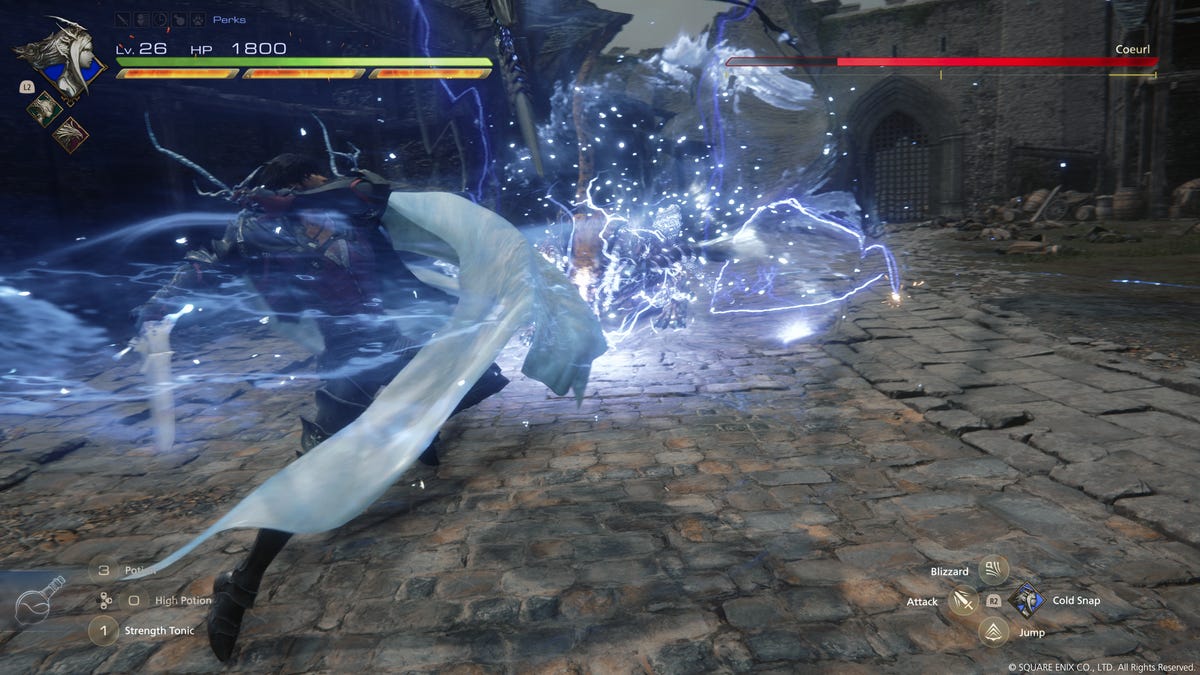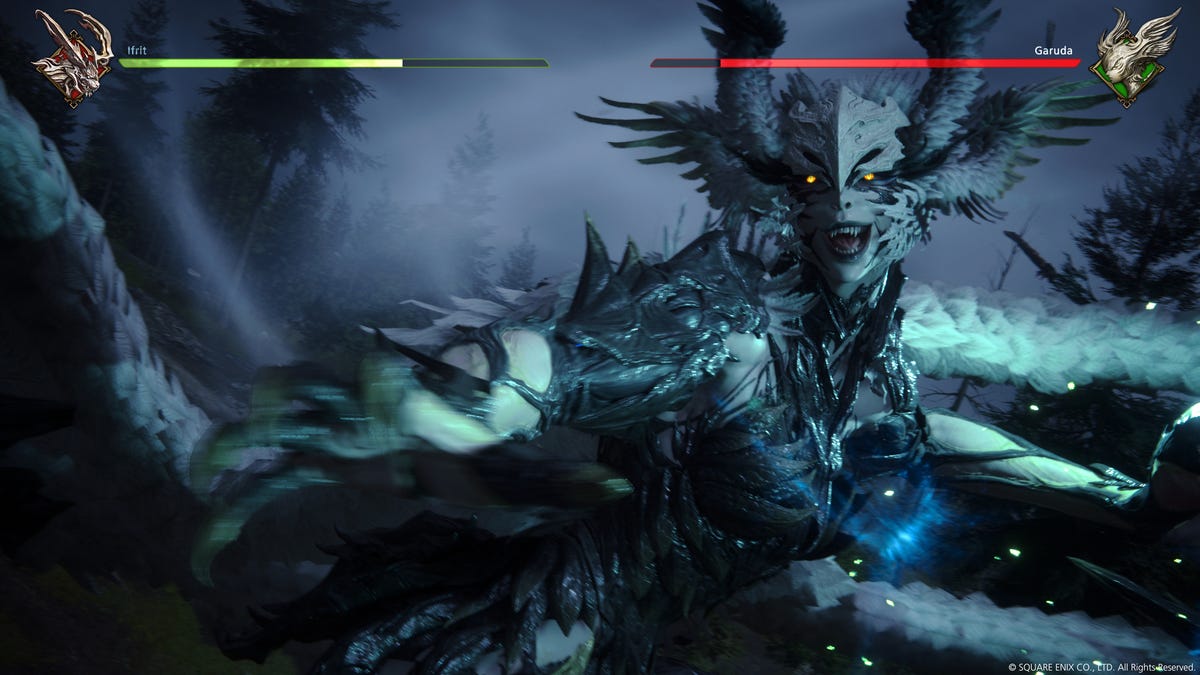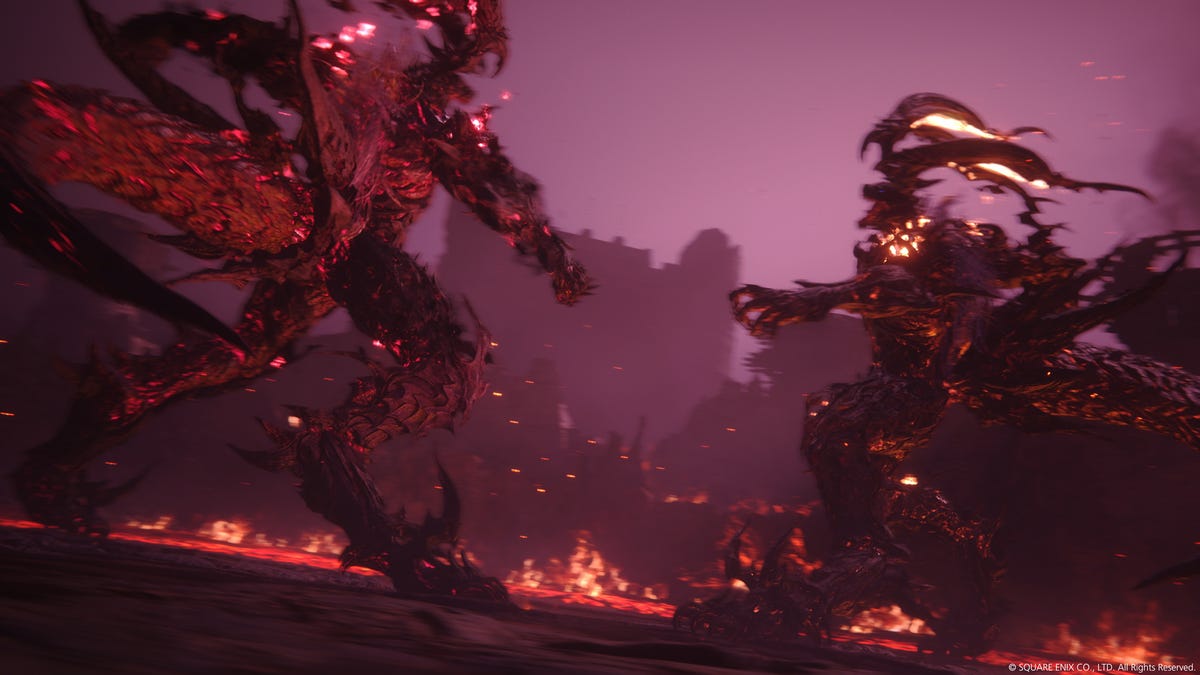Technologies
Final Fantasy XVI Drags the RPG Series Into Incredible Action Territory
Preview: Square Enix reveals the story and combat of the next entry in its iconic series before it hits PS5 this summer.

Every main numbered Final Fantasy game tells a new story in a fresh universe, giving each upcoming entry a powerful mystique. That sense is particularly strong with Final Fantasy XVI, which has been teased with spectacular, overwhelming trailers since 2020.
The PS5 exclusive lands on June 22, and developer Square Enix lifted the curtain at a New York City preview event with a playable demo build of the game earlier this month. Acting as producer is Naoki Yoshida (AKA Yoshi-P), the charismatic figure credited with reviving massively multiplayer online RPG Final Fantasy XIV. He and his team gave us a primer on the story and world before letting us try out the game for the first time.
World at war
This RPG takes place in Valisthea, a world divided into six nations that depend on giant magic crystals — one of Final Fantasy’s recurring elements — for energy. As the game kicks off, this energy is badly depleted and conflict is brewing between Valisthea’s nations.
It’s more of a cold war due to the existence of Dominants — humans with the power to summon massive magical creatures known as Eikons. Like the dragons in Games of Thrones, the Eikons are basically this world’s weapons of mass destruction. Except all the nations have them, and they act as a deterrent to open war.
You play as Clive Rosfield, whose younger brother Joshua has control of the powerful Phoenix summon. After tragedy strikes (its exact nature was unclear in the preview), Clive is bound to another fiery Eikon, Ifrit, and goes on a quest for vengeance. This causes Eikons to battle each other for the first time, throwing off Valisthea’s delicate political balance and creating lots of collateral damage.


The Phoenix Eikon is central to the game’s epic tale.
Square EnixClive’s journey will take him through Valisthea’s seven nations — which are divided into segmented open areas rather than one big open world — with a shifting party of AI-controlled allies as backup (there wasn’t much exploration in the preview section though). You’ll also be able to dive into the history of Valisthea as much as you wish, Localization Director Michael-Christopher Koji Fox told CNET.
«We have a character that gathers lore; he will tell you about what’s going on in the game — characters, places, history, things like that,» said Koji Fox, whose previous Final Fantasy projects include IX and XIV. «It doesn’t affect the story, it doesn’t affect gameplay, but for those players that want to go deep and find out what happened 200 years ago, why these countries hate each other, you can go and do that.»
Dominating the Dominants
The playable section of our demo saw Clive and his ally Cidolfus Telamon (this game’s Cid, a recurring name in the series) making their way up a dark tower on the hunt for Benedikta Harman, a spy for a rival nation. Cid is the Dominant of lightning-summoning Ramuh, while Benedikta is linked to terrifying wind elemental Garuda.
Cid has beautifully styled hair and his voice will likely sound familiar — he’s voiced by Ralph Ineson, who appeared in Game of Thrones, Chernobyl and Willow and infuses his character with awesome gravitas. The fiery Benedikta is easily the most striking character design in the preview, and you know she’s a baddy because drops the f-bomb.


Benedikta is a pretty intense rival for Clive.
Square EnixThese Dominants humanize the political conflict, and their differing statuses within their own kingdoms hint at the varying cultures and attitudes across this world. This section occurs a few hours into the game, though there’s also a tutorial where you play as a young, fresh-faced Clive to learn the basics of combat.
The dingy tower wasn’t exactly a visual showcase for the first PS5 Final Fantasy, which will let you choose between performance and fidelity modes in the finished game. However, this location did offer plenty of opportunities to explore the game’s real-time combat system as goons leapt out at every turn. Unlike Final Fantasy VII Remake, you don’t control your entire party directly — only Clive and his faithful canine companion Torgal (whom you can pet).
Tailoring your battles
Basic combat fits neatly in the action-RPG mold, with Clive able to employ a mixture of melee attacks, magic, dodging and blocking. Final Fantasy XVI’s battles move much more quickly than those old games though, and combat director Ryota Suzuki drew on his experience developing lightning-fast action game Devil May Cry 5 for this series evolution.
«The most important thing for Final Fantasy XVI was to make a system that is accessible to lots of different types of playing styles; more technical, stylish and for players that are not too into action,» Suzuki said via translator. «So we didn’t want it to be overwhelming.»


Torgal is an exceptionally good dog and useful in a fight.
Square EnixAdding to Final Fantasy XVI’s accessibility are the «Timely» accessories, which you can equip to simplify certain aspects of combat. These can let you pull off Clive’s most impressive combos by tapping the same button (instead of learning specific inputs), allow for easier dodging and make doggo pal Torgal battle automatically.
You can tailor this element based on which ones you equip, giving you a chance to get comfortable with different parts of the combat system at your own pace. The attack one had the most obvious impact, since unequipping it reduced Clive’s attacks from visually stunning Devil May Cry-style aerial ballets to basic thrusts and chops — you’ll have to learn a bunch of combos to achieve his most stylish moves normally.
Elemental Eikons
Your magical combat abilities are defined by the Eikon you have equipped, with Phoenix’s fire, Titan’s earth and Garuda’s wind were available in the demo, but it seems like Clive absorbs or copies these from other Dominants as he encounters them (it’s likely Garuda’s powers were unlocked early for the demo version). Earning experience lets you unlock or improve Clive’s elemental skills.


You can channel Eikons to employ elemental attacks in battle.
Square EnixYou can also switch between Eikons in battle, essentially allowing Clive to change character classes on the fly. It’s an evolution of the beloved job system that debuted in 1992’s Final Fantasy V, in which you assigned roles to characters and they learn those job-specific abilities through leveling up.
«It was my wish to take that job system and somehow replace jobs with Eikons, and recreate that system in a full action setting,» game director Hiroshi Takai, who worked on the fifth entry in the series, said through a translator.
«Making it something that’s very customizable and individual to each player … the Clive they have at the end and the palette they use in that final battle is different for every single person.»


Garuda is awesome looking throughout the intense boss battle.
Square EnixFlipping between these elemental powers became increasingly natural as the demo progressed, with the mixture of these and the satisfying dodge system making the boss battle against Benedikta and her Eikon a joy to play. The smooth transitions between gameplay and cutscenes peppered the experience with that classic Final Fantasy melodrama without pulling control away for too long.
Battle of the titans
The final section of the demo took place a few hours further into the game, with Ifrit going up against Benedikta’s Garuda in an epic Godzilla vs Kong-style confrontation. It’s the kind of sequence that would have been a cutscene in older Final Fantasy games, but XVI makes it completely playable and extremely fun.
This battle felt completely different to normal combat, conveying an awesome sense of primordial power as the Eikons lay waste to an isolated part of Valisthea. Ifrit employs a mixture of beefy melee moves and fiery blasts against Garuda’s quick slashes and wind-based attacks. Projectiles also neutralize each other, which is a particularly cool touch.


The Eikons are a force of nature, and their clashes make a huge mess.
Square EnixThe developers noted that the gameplay of these Eikon clashes will vary, hinting that you’ll have to battle each one differently depending on their elemental prowess, unique attributes and Clive’s relationship with the character who’s controlling them.
Even with the shift toward action-oriented battles, Final Fantasy XVI looks set to be an emotional roller coaster in the series’ grand tradition. Speaking through a translator, producer Naoki Yoshida wants players to feel thrilled and hopeful by the time they’re done with the game.
«When those end credits roll and the players experience the whole story, I want them to feel that they can move toward tomorrow, no matter what happened today,» he said.
Technologies
Today’s NYT Mini Crossword Answers for Saturday, Dec. 27
Here are the answers for The New York Times Mini Crossword for Dec. 27.

Looking for the most recent Mini Crossword answer? Click here for today’s Mini Crossword hints, as well as our daily answers and hints for The New York Times Wordle, Strands, Connections and Connections: Sports Edition puzzles.
Need some help with today’s Mini Crossword? It’s pretty long for a Mini Crossword, and some of the clues are tricky. The answer to 10-Across is not an expression I use, for sure. Read on. And if you could use some hints and guidance for daily solving, check out our Mini Crossword tips.
If you’re looking for today’s Wordle, Connections, Connections: Sports Edition and Strands answers, you can visit CNET’s NYT puzzle hints page.
Read more: Tips and Tricks for Solving The New York Times Mini Crossword
Let’s get to those Mini Crossword clues and answers.
Mini across clues and answers
1A clue: Fashionable
Answer: HIP
4A clue: Product sold on «The Office»
Answer: PAPER
6A clue: One writing a performance review
Answer: MANAGER
8A clue: With 5-Down, redundant synonym of «outcome»
Answer: END
9A clue: Quiet ___ mouse
Answer: ASA
10A clue: Gives constant compliments, in slang
Answer: GASESUP
12A clue: Ski mountain bump
Answer: MOGUL
13A clue: Uneasy feeling
Answer: ANGST
Mini down clues and answers
1D clue: Personally involved
Answer: HANDSON
2D clue: Hoppy beer, for short
Answer: IPA
3D clue: Mythical horse whose name is an anagram of 10-Across
Answer: PEGASUS
4D clue: Last word in the palindromic sentence «A man, a plan, a canal …»
Answer: PANAMA
5D clue: See 8-Across
Answer: RESULT
6D clue: Ryan of «When Harry Met Sally …»
Answer: MEG
7D clue: Genre for Playboi Carti and Cardi B
Answer: RAP
11D clue: Something in an Easter basket
Answer: EGG
Don’t miss any of our unbiased tech content and lab-based reviews. Add CNET as a preferred Google source.
Technologies
Today’s NYT Connections: Sports Edition Hints and Answers for Dec. 27, #460
Here are hints and the answers for the NYT Connections: Sports Edition puzzle for Dec. 27, No. 460.

Looking for the most recent regular Connections answers? Click here for today’s Connections hints, as well as our daily answers and hints for The New York Times Mini Crossword, Wordle and Strands puzzles.
Today’s Connections: Sports Edition is a real challenge. That purple category wants you to hunt out something related in four different words, and it’s a toughie. If you’re struggling with today’s puzzle but still want to solve it, read on for hints and the answers.
Connections: Sports Edition is published by The Athletic, the subscription-based sports journalism site owned by The Times. It doesn’t appear in the NYT Games app, but it does in The Athletic’s own app. Or you can play it for free online.
Read more: NYT Connections: Sports Edition Puzzle Comes Out of Beta
Hints for today’s Connections: Sports Edition groups
Here are four hints for the groupings in today’s Connections: Sports Edition puzzle, ranked from the easiest yellow group to the tough (and sometimes bizarre) purple group.
Yellow group hint: Something you save.
Green group hint: An Olympic sport.
Blue group hint: Toronto pitchers.
Purple group hint: Think about the alphabet and look for something hidden.
Answers for today’s Connections: Sports Edition groups
Yellow group: Memento.
Green group: Types of wrestling.
Blue group: Blue Jays to win Cy Young Award.
Purple group: Ends in a homophone for a letter of the alphabet.
Read more: Wordle Cheat Sheet: Here Are the Most Popular Letters Used in English Words
What are today’s Connections: Sports Edition answers?
The yellow words in today’s Connections
The theme is memento. The four answers are collectible, keepsake, memorabilia and souvenir.
The green words in today’s Connections
The theme is types of wrestling. The four answers are arm, freestyle, Greco-Roman and sumo.
The blue words in today’s Connections
The theme is Blue Jays to win Cy Young Award. The four answers are Clemens, Halladay, Hentgen and Ray.
The purple words in today’s Connections
The theme is ends in a homophone for a letter of the alphabet. The four answers are batter’s eye (I), blue jay (J), golf tee (T) and pool cue (Q).
Don’t miss any of our unbiased tech content and lab-based reviews. Add CNET as a preferred Google source.
Technologies
Today’s Wordle Hints, Answer and Help for Dec. 27, #1,652
Here are hints and the answer for today’s Wordle for Dec. 27, No. 1,652.

Looking for the most recent Wordle answer? Click here for today’s Wordle hints, as well as our daily answers and hints for The New York Times Mini Crossword, Connections, Connections: Sports Edition and Strands puzzles.
Today’s Wordle puzzle came together pretty quickly for me this time. If you need a new starter word, check out our list of which letters show up the most in English words. If you need hints and the answer, read on.
Read more: New Study Reveals Wordle’s Top 10 Toughest Words of 2025
Today’s Wordle hints
Before we show you today’s Wordle answer, we’ll give you some hints. If you don’t want a spoiler, look away now.
Wordle hint No. 1: Repeats
Today’s Wordle answer has no repeated letters.
Wordle hint No. 2: Vowels
Today’s Wordle answer has one vowel.
Wordle hint No. 3: First letter
Today’s Wordle answer begins with B.
Wordle hint No. 4: Last letter
Today’s Wordle answer ends with H.
Wordle hint No. 5: Meaning
Today’s Wordle answer can refer to a quantity of goods produced at one time.
TODAY’S WORDLE ANSWER
Today’s Wordle answer is BATCH.
Yesterday’s Wordle answer
Yesterday’s Wordle answer, Dec. 26, No. 1651 was SPEED.
Recent Wordle answers
Dec. 22, No. 1647: CONCH
Dec. 23, No. 1648: GLINT
Dec. 24, No. 1649: SPOOL
Dec. 25, No. 1650: PRISM
Don’t miss any of our unbiased tech content and lab-based reviews. Add CNET as a preferred Google source.
-

 Technologies3 года ago
Technologies3 года agoTech Companies Need to Be Held Accountable for Security, Experts Say
-

 Technologies3 года ago
Technologies3 года agoBest Handheld Game Console in 2023
-

 Technologies3 года ago
Technologies3 года agoTighten Up Your VR Game With the Best Head Straps for Quest 2
-

 Technologies4 года ago
Technologies4 года agoBlack Friday 2021: The best deals on TVs, headphones, kitchenware, and more
-

 Technologies4 года ago
Technologies4 года agoVerum, Wickr and Threema: next generation secured messengers
-

 Technologies4 года ago
Technologies4 года agoGoogle to require vaccinations as Silicon Valley rethinks return-to-office policies
-

 Technologies4 года ago
Technologies4 года agoOlivia Harlan Dekker for Verum Messenger
-

 Technologies4 года ago
Technologies4 года agoiPhone 13 event: How to watch Apple’s big announcement tomorrow

